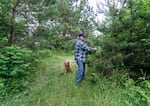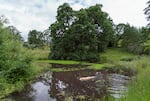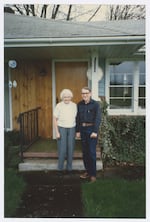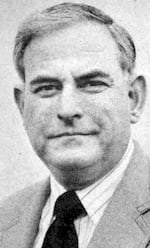OPB senior political reporter Jeff Mapes spent more than a year researching, reporting and producing “Growing Oregon,” a six-part podcast and web series looking at the evolution of Oregon’s unique approach to growth and the impact it has on our lives today. Here’s the story behind the story. In Part 1 we visited a time when Oregon’s farms and scenic beauty were under attack. This is Part 2. Listen to today’s story:
Gordon Fultz lives just 15 miles from the state Capitol in Salem. But his wildlife refuge on a hillside in the Willamette Valley feels much further away.
To get here, I drove up a long gravel road, past Hazelnut orchards, vineyards and Christmas tree farms.
I’m visiting Fultz because he’s one of the last people still alive who played a big role in creating Oregon’s growth management system. I’m talking about Senate Bill 100, maybe the most famous — and most important — legislation ever considered in Salem.

Gordon Fultz clears a path through his nearly 30-acre wildlife refuge near Amity, Ore., June 16, 2022. Fultz was a lobbyist for the Association of Oregon Counties and helped create Oregon’s growth management system.
Kristyna Wentz-Graff / OPB
Back in 1973, he had just left California for a job up here lobbying for the Association of Oregon Counties. He quickly got in the middle of the debate over what to do about the state’s booming population.
“The uncontrolled development that was occurring everywhere, and without much planning, that’s what seemed to be the major concern that everybody really wanted to address,” Fultz said.
Back then, that fight was part of his job. Now Fultz is retired, and the issue feels much more personal.
With the help of government grants, Fultz turned his 30-acre plot into a wildlife refuge. It’s a dense, unruly thicket filled with ancient oak trees, wetlands and evergreens. It’s a glimpse at the way things looked when forests blanketed the Willamette Valley.
What makes it interesting — at least from a political perspective — is that this land would likely look very different if Oregon hadn’t taken a strict approach to manage its open spaces.
“If land use weren’t here,” Fultz said, “this would be homes.”
The love that Fultz has for his private refuge today reminds me of the way a lot of Oregonians felt back in the late 1960s and ‘70s. Their state was growing like crazy, with few checks on where development would occur. People looking south to California got a glimpse at what they didn’t want Oregon to become.
As a California transplant himself, Fultz could relate. He had worked around the famously hardball California Legislature, and he was also struck by how different he found the political climate in Oregon at the time.

Gordon Fultz’s dog Biscuit swims through one of several ponds on Fultz’s nearly 30-acre wildlife refuge near Amity, Ore., June 16, 2022. Fultz arrived in Oregon at a time when farmers and environmentalists alike worried that sprawl and development would threaten the state's agriculturalal and rural areas.
Kristyna Wentz-Graff / OPB
“I came up here and I was, ‘This is magnificent,’” Fultz said “It was open. It doesn’t matter whether you’re Republican or Democrat, you were trying to work for the betterment of the state.”
That might be overstated a bit. There were plenty of bitter political fights here. But party lines just weren’t so rigid then.
Liberal Republican Tom McCall was governor. Democrats controlled the Legislature. But some of their leaders were conservatives from rural Oregon.
The geographical divides weren’t so rigid either. Timber was the state’s biggest industry. Average pay in many rural counties was as high as in the cities.
The commitment to political reform was strong in the wake of the Watergate scandal that would force Richard Nixon out of the presidency. Oregon legislators passed public record and open meeting laws. A new crop of young people won election to office in 1972, as well as a record number of women.
These legislators didn’t shy from taking on an ambitious agenda. McCall also wanted to do big things. The 1973 session was his last before he had to leave office under term limits. It looked like a moment at which legislators could do something meaningful to protect the state’s farms and scenic landscapes.
This turned out to be much tougher than most lawmakers expected. As it happened, a lot of people got very angry when they learned that some of the control of their land was slipping away from them.
‘Oregon as we know it will be lost’
Back in 1973, the dominant mood among Oregonians was a feeling that they were under invasion.
Farmers and environmentalists alike warned that the agricultural future of the Willamette Valley was under dire threat.
Oregon Secretary of State Clay Myers, the No. 2 state official, insisted that “We must have some bulwark against the tide of immigrants.” Bear in mind he was talking about people from other states, not other countries.
Oregon’s very future was at stake, Myers added.
“If we do not win the land-use planning battle in the next few years,” he said, “then Oregon as we have known it will be completely lost within the next two or three decades.”
At the start of the legislative session, Gov. McCall, a former newspaper reporter and TV commentator, put his considerable rhetorical skills to work to demand action on growth.
“The interests of Oregon for today and in the future must be protected from grasping wastrels of the land,” he said. “We must respect another truism, that unlimited and unregulated growth leads inexorably to a lowered quality of life.”

Tom McCall, Governor of Oregon from 1967–1975.
Courtesy of the Oregon State Archives
McCall had already pushed growth management legislation through in 1969. But it proved to be weak. Local governments often ignored it.
Fultz recalled that, early in the session, McCall backed him and his boss into the corner of a Capitol hallway.
The county association had its doubts about the bill. And the counties were a key player since they were so involved in zoning decisions. The 6-foot-5 McCall demanded their help getting tougher controls.
“It was like him standing 9 feet tall and us standing about 2 feet tall,” Fultz recalled with a laugh. “And we said, ‘Yes sir, we’ll be working on that.’”
McCall left the details to his aides — and to Republican Sen. Hector Macpherson. He was a dairy farmer near Corvallis who had been putting together a bill long before the session. He was now the chief sponsor, along with Sen. Ted Hallock, D-Portland.
Macpherson was a cool customer. Take his World War II service, when he was on bombers in Europe and saw plenty of combat.
“No one on the plane I was ever on was hurt,” he told the Oregon Historical Society years later. “You know [we] came back with 15 or 20 pieces of flak going through the plane. But nobody got a purple heart on my plane. And so far as I’m concerned, the war was a breeze.”
Hallock, ironically, had also seen service on a World War II bomber. While he came through the war without physical injury, he often talked about how the experience left him emotionally scarred. That fit his personality. Hallock was more mercurial than Macpherson.
But he was a skilled legislative tactician and the two worked well together. And they wouldn’t let a little political flak stop them from producing a tough bill.

Hector Macpherson Jr., 1992, with wife, Kitty Macpherson, at their home in Oakville, Oregon.
Clark Hansen / Oregon Historical Society
Their proposal called for a new state bureaucracy to pass judgment on local development plans. Some lands would be under direct state control. In addition, counties and cities would have to pass on their zoning plans to newly created regional councils before the state had the final say.
That made Fultz’s bosses at the counties nervous — as well as their city counterparts. It’s clear they were going to lose a lot of power. Fultz said there were huge divides among the interest groups generally.
“It ran all the way from, we don’t want any land use to, let’s lock down everything,” he said.
McCall and the legislative sponsors of Senate Bill 100 decided they needed help. So they turned to a Teamsters union official named L.B. Day.
They wanted him to lead a group of lobbyists that would privately hammer out a deal.
It might seem odd to involve a Teamsters official. But the key was that Day didn’t just represent truck drivers.
“L.B.’s Teamsters were ladies, most of them little old ladies that worked in canneries,” Republican politician Norma Paulus once explained. “That was L.B.’s constituency.”
The jobs for these little old ladies depended on a steady supply of farm produce. And for years, Day had fought as hard as any tractor-driving farmer to protect ag land in the Willamette Valley.
In a KOIN-TV interview from the time, Day explained that paving over farmlands and cutting down forests “sure as hell affects our economy and our jobs. And certainly, we’re going to have something to say.”

L.B. Day, from the Marion County Voters' Pamphlet, 1978.
Public domain
He also knew the process well. He was a former state representative and a former director for the state Department of Environmental Quality.
I would later cover Day when he was a state senator. He was one of those larger-than-life figures. He had an opinion on everything, a booming voice and a piercing sense of humor. He wasn’t shy about running over people to get his way.
Day insisted on personally choosing the three lobbyists who would most closely work with him on the legislation rewrite. One was Fred Van Natta, the powerful homebuilders’ lobbyist. Another was Ward Armstrong, a timber lobbyist. Big timber had more private land in the state than anyone, so they also had to be part of it. And the third lobbyist was Fultz, to bring the counties along.
Under Day’s direction, the tight little group dug into the guts of the bill.
Day would make a flurry of late-night calls to Fultz and the other lobbyists to float various ideas.
“So after a 10 or 11 o’clock meeting or discussion with him at night, he’d want to meet at seven o’clock in the morning in the Capitol coffee shop or somewhere else to have breakfast,” recalled Fultz.
Their rewrite dumped a lot of the controversial stuff. For example, no more provisions about direct state control of lands. No regional councils.
They strengthened the role of counties, which made Fultz happy. And they delegated a lot of the decisions about just how this system would work to a new state planning czar.
The final version that Day’s group came up with was a deal most legislators could accept. They could tell constituents they were doing something about out-of-control growth — without voting for something too scary.
Fultz said the idea was that the bill would be finely balanced between conservation and development. Nobody would have too much power. “It was to be basically a collaboration” between the different levels of government, he said.
The measure passed the state Senate with only a couple of votes to spare.
Hallock told his colleagues in the House not to change a single period in the bill (he told McCall biographer Brent Walth that he added the f-word to his command). Hallock worried that the compromise was so tentative that it would fall apart if any further changes were made.
House members grumbled but fell into line.
Rep. Nancy Fadeley, D-Eugene, chaired the House committee in charge of the bill. She said the measure was so vague that she “wasn’t sure how much good it would actually do. But it was the only legislation that offered any hope.”
The measure cleared the House by a wider margin than the Senate and was signed by McCall on May 29, 1973.
But the fight wasn’t over.
Empowering the people
After signing Senate Bill 100, McCall gave L.B. Day an even bigger job. He put him in charge of the new Oregon Land Conservation and Development Commission. This panel would oversee a new department that would administer the state’s growth controls.
The commission’s first task was to write goals guiding how cities and counties would develop their plans. These goals were to be broad statements of policy, such as protecting farmland whenever possible.
Senate Bill 100 said there had to be “widespread” citizen participation every step of the way. So this new state agency set up public meetings in every nook and cranny of Oregon.
It was said to be the largest public outreach program in the state’s history. McCall cut radio ads urging Oregonians to show up at those meetings.
And those gatherings were indeed large — and boisterous.
Many participants said Oregon needed to protect farm and forest land in a world that wasn’t making more of it. Others said this looked like the biggest violation of private property rights they’d ever seen.

A landscape of farms and forests near Amity, Ore., June 16, 2022.
Kristyna Wentz-Graff / OPB
In a lot of the commentary, there was definitely the feeling, “Let’s just stop growth.”
For example, documentarian Bill Bradbury (who later became a top Democratic legislator and then secretary of state) captured one participant laughing at the question of what should be done for the future. Her response: “How about machine guns at the borders?”
The new commission, short of time and money, raced through setting the goals. In many ways, Fultz said, it was L.B. Day’s call.
“It wasn’t as though there were, whatever, five or seven equal parties,” Fultz said. “It was going to be L.B.’s way.”
All told, the commission adopted 19 goals. Perhaps the most monumental of them required something called an “urban growth boundary” around every city. These invisible lines would be the main defense against sprawl. They could be moved if needed to accommodate population growth. But the idea was that no longer would subdivisions leap far into the countryside.

Urban growth boundaries around cities across Oregon. Source: Department of Land Conservation and Development, 2017
MacGregor Campbell / OPB
Some counties already had their own versions of a growth boundary. But Fultz said this change shocked many property owners.
They complained that they suddenly found themselves on the wrong side of the line, “and you’ve taken my ability to make several hundred thousand dollars on these lots.”
Despite that, Fultz said, he and his county leaders thought the process of setting the goals had gone pretty well. But the tension would grow.
1000 Friends of Oregon emerges to enforce planning goals
As counties began putting together their required plans for managing growth, a new force emerged. It was a watchdog group called 1000 Friends of Oregon.
A young public interest lawyer named Henry Richmond set up the non-profit to fight for strong controls. And he had the backing of Tom McCall, who became the new group’s advisory board chairman after leaving the governorship.
Richmond was a shrewd operator. He was inspired by consumer advocate Ralph Nader to use the law to make a difference. With Nader’s encouragement, he had helped found the Oregon Student Public Interest Research Group in 1971.
Meanwhile, Richmond learned from his father, a former Bonneville Power administrator, how to be pragmatic and speak to the business community. Crucially, one of Richmond’s key supporters was the state’s most powerful behind-the-scenes power broker: businessman Glenn Jackson.
The group quickly made an impact.
Ed Sullivan, a land-use lawyer who has followed the growth management system since its beginning, said that 1000 Friends told local governments they “just can’t set up a bigger urban growth boundary and take up farmland. You have to justify it.”
I talked with Richmond several months before he died in 2021.
“There was always some lawyer working for one of the local governments who would try to write the law or interpret the law into mush or out of existence,” he said.
One of Richmond’s first victories was a case out of Marion County. Officials there wanted to carve some prime farmland into 10-acre parcels.
That would make it easier for people to sell off chunks of their land to raise cash. But Richmond successfully argued those lots were too small to support commercial farming. They would just bring more sprawl into the country.
The victories quickly mounted.
Dick Benner, one of the first lawyers hired by Richmond, noted that the Land Conservation and Development Commission was very small at the time and didn’t have the budget to enforce its new rules.
“1000 Friends essentially became the enforcement arm for the statewide planning goals,” Benner said. “So we were just going left and right, shooting guns in every direction.”
Benner and Bob Stacey, Richmond’s other early legal hire, both went on to be influential figures in Oregon’s land control system. Benner ran the Department of Land Conservation and Development for nine years. Stacey ran Portland’s planning bureau and was later a councilor with Metro, the Portland region’s tri-county government.
Fultz said he had complicated feelings about Richmond’s group. He admired the skill of the group’s attorneys. But he worried too many issues were being decided by the courts. Many county leaders felt increasingly powerless. And in fact, the association Fultz worked for became so divided that it stopped taking a position on the growth system.
A day to remember at the Capitol
The acronym for the land conservation commission — LCDC — became a cussword to many rural voters. They couldn’t believe they no longer had as much control as they’d previously had over their own land.
Fultz was feeling the heat too. One time he had a beer with a previously friendly legislator. But the lawmaker wound up cursing out Fultz over land use — and then angrily stomped out of the bar.
Another time, Fultz was on the south coast for a routine meeting with county officials. Somehow, the word got out to the public that it was really an LCDC meeting.
More than 200 people showed up. They chewed Fultz and the county leaders out for an hour. It didn’t matter that Fultz and the others insisted they weren’t the LCDC.
And then there was the day in the Capitol that Fultz will never forget.
He was walking toward the House chamber when two strangers approached him.
Fultz said they told him, “We don’t like this land-use system, and I understand you’re part of this.”
The older man carried the conversation at first, talking about some land they owned in Central Oregon.
Then the younger man stepped up.
“He pulled a gun, and he said, ‘Listen, you know, we’re very serious about this, and we want to be able to develop land where we want to develop it. We own it.’”
Fultz said he tried to stay calm.
“These guys don’t seem like they’re wanting to beat me up or anything. I mean, the gun was just, I think, more for show,” he said. “But it scared me.”
Fultz was eventually able to de-escalate the situation. He assured the two men that everyone wanted the system to work reasonably. The younger man put his gun away and the two walked away.
For his part, Fultz went to the state police who guarded the Capitol. But they couldn’t find the men.
The backlash against the new law went on for years. Many county commissioners got recalled because of debate over it.

Gordon Fultz at his nearly 30-acre wildlife refuge near Amity, Ore., June 16, 2022. In 1973, Fultz was deeply engaged in the work of crafting Oregon's growth management system of land-use restrictions.
Kristyna Wentz-Graff / OPB
Opponents put measures on the ballot in 1976 and 1978 to gut the statewide controls. But voters strongly rejected those measures.
At that point, you’d think the future of the growth-management system looked secure. However, it faced another big challenge. In the early 1980s, Oregon’s economy went into severe recession as the Federal Reserve jacked up interest rates to fight runaway inflation. Home construction took a dive, devastating the state’s timber industry.
Opponents saw a new chance to kill Oregon’s land-use system. They put another initiative on the ballot in 1982, this time to make the planning goals voluntary.
An early poll suggested that, in the rush to improve Oregon’s economy, voters might be ready to dump the system. Attracting growth suddenly seemed more attractive.
Many businesspeople argued they wanted to make it clear Oregon was open to business. Meanwhile, supporters of the system ran ads showing California developers wanting to despoil scenic areas like the coast.
In the end, the election may have come down to the man who was no longer governor: Tom McCall.
By 1982, McCall had been out of office for eight years. He was back doing commentary on TV. And he was fighting cancer.
Part of McCall’s TV deal was that he wouldn’t get involved in campaigns. But McCall was speaking at a fundraiser for an environmental group just weeks before the election. Henry Richmond, the 1000 Friends founder, was sure that McCall would have something to say about the ballot measure. He arranged for a film crew to be present.
McCall did not disappoint.
“This may sound corny, but this activist loves Oregon more than life,” McCall told the crowd at the fundraiser. He explained that his doctor warned him that stress would even further weaken him. But McCall said that was OK, he was willing to take on the stress of speaking out against this measure.
“If the legacy we have helped give Oregon, and made it twinkle from afar,” McCall said, “if it goes, I guess I wouldn’t want to live in Oregon anyhow.”
Voters sided with the ex-governor. Despite the bad economy, voters made it clear once again that they wanted the growth management system to stay.
From that point, it became part of what makes Oregon what it is. Like public access to the beaches. Or no sales tax.
Back at Gordon Fultz’s wildlife refuge, Fultz reminisces about how tough the early years of the system were for him and for his employers — the counties and county commissions of Oregon.
“The process, I wish, had a been a little bit different,” he said. “And I think it could have saved a bunch of commissioners and could have caused some guns not to be pulled.”
Maybe, he allowed, there was no way for such sweeping changes to occur without the bitterness and the repeated political and legal battles.
“You know, we are where we are,” he said, adding, “I liked the result, I like what we’ve done.”
Next week: By the early 1980s, Oregon’s land use system was clearly here to stay. Most Oregonians agreed: They wanted to preserve the landscape outside cities. But precisely how we should live within those new urban growth lines? That was an entirely different — and even more heated —fight.
The Growing Oregon audio story is available through the OPB Politics Now podcast feed.

OPB Politics Now
OPB Sta
